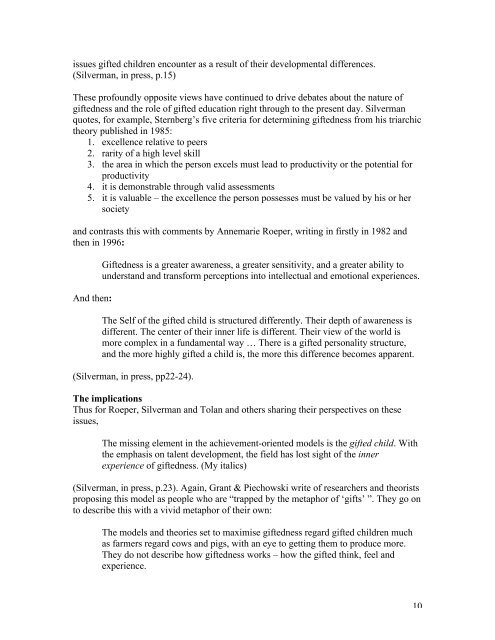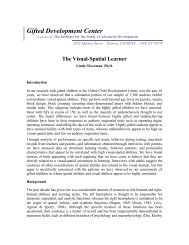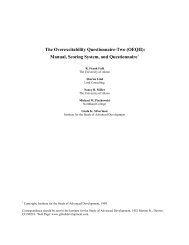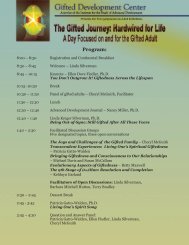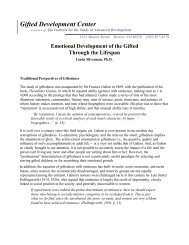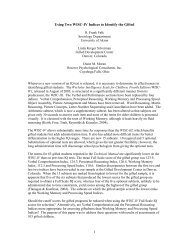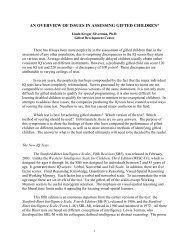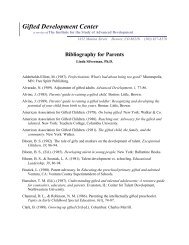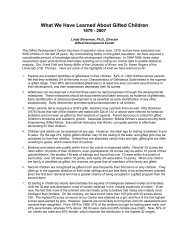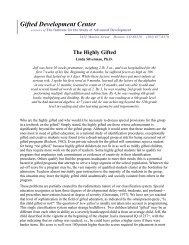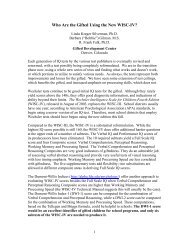THE CONUNDRUMS OF SUCCESS - the Gifted Development Center
THE CONUNDRUMS OF SUCCESS - the Gifted Development Center
THE CONUNDRUMS OF SUCCESS - the Gifted Development Center
Create successful ePaper yourself
Turn your PDF publications into a flip-book with our unique Google optimized e-Paper software.
issues gifted children encounter as a result of <strong>the</strong>ir developmental differences.(Silverman, in press, p.15)These profoundly opposite views have continued to drive debates about <strong>the</strong> nature ofgiftedness and <strong>the</strong> role of gifted education right through to <strong>the</strong> present day. Silvermanquotes, for example, Sternberg’s five criteria for determining giftedness from his triarchic<strong>the</strong>ory published in 1985:1. excellence relative to peers2. rarity of a high level skill3. <strong>the</strong> area in which <strong>the</strong> person excels must lead to productivity or <strong>the</strong> potential forproductivity4. it is demonstrable through valid assessments5. it is valuable – <strong>the</strong> excellence <strong>the</strong> person possesses must be valued by his or hersocietyand contrasts this with comments by Annemarie Roeper, writing in firstly in 1982 and<strong>the</strong>n in 1996:And <strong>the</strong>n:<strong>Gifted</strong>ness is a greater awareness, a greater sensitivity, and a greater ability tounderstand and transform perceptions into intellectual and emotional experiences.The Self of <strong>the</strong> gifted child is structured differently. Their depth of awareness isdifferent. The center of <strong>the</strong>ir inner life is different. Their view of <strong>the</strong> world ismore complex in a fundamental way … There is a gifted personality structure,and <strong>the</strong> more highly gifted a child is, <strong>the</strong> more this difference becomes apparent.(Silverman, in press, pp22-24).The implicationsThus for Roeper, Silverman and Tolan and o<strong>the</strong>rs sharing <strong>the</strong>ir perspectives on <strong>the</strong>seissues,The missing element in <strong>the</strong> achievement-oriented models is <strong>the</strong> gifted child. With<strong>the</strong> emphasis on talent development, <strong>the</strong> field has lost sight of <strong>the</strong> innerexperience of giftedness. (My italics)(Silverman, in press, p.23). Again, Grant & Piechowski write of researchers and <strong>the</strong>oristsproposing this model as people who are “trapped by <strong>the</strong> metaphor of ‘gifts’ ”. They go onto describe this with a vivid metaphor of <strong>the</strong>ir own:The models and <strong>the</strong>ories set to maximise giftedness regard gifted children muchas farmers regard cows and pigs, with an eye to getting <strong>the</strong>m to produce more.They do not describe how giftedness works – how <strong>the</strong> gifted think, feel andexperience.10


